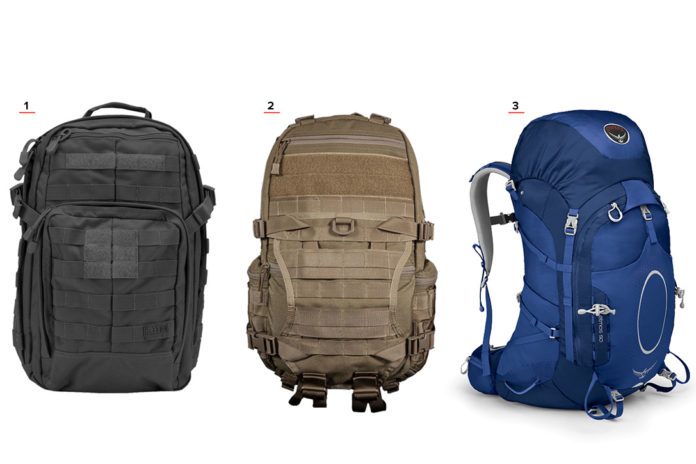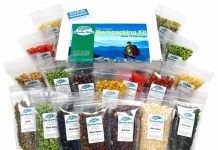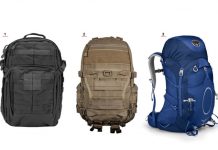The 72 Hour Kit
In simple terms a 72 hour kit is a kit which gives you everything you need to sustain life for seventy two hours. Unfortunately; many pre-packed systems that can be purchased online and some emergency preparedness ‘experts’ advocate an approach to this that is at best incomplete.
These packs and people suggest that you will be able to rely on emergency services; government aid and other support in an emergency and as such the kits they recommend are aimed at life in an evacuation centre or aid station. While in an emergency that is the most likely course of events to plan for it and pack your bag accordingly is really an oversight on your part. You need to be prepared to survive without any outside assistance.
So; a seventy two hour pack needs to be a COMPREHENSIVE survival system which contains everything you need for three days in the worst possible conditions that you might face in your location.
That means packing for winter rather than summer so that you will be able to survive whatever time of year disaster might strike. A bug out bag will provide all the same necessities that a seventy two hour kit will and really differs more in terms of the philosophy of its use than in any other way.
Bug Out Bag
A bug out bag is a bag packed to give you the basic necessities to sustain life if you had to leave or ‘bug out’ of home in an emergency situation. There is no finite 72 hour period associated with a bug out bag although realistically the amount of food you will pack won’t ever extend to much more than this due to weight implications.
It just isn’t realistic to carry more than a third of your body weight for any length of time over rough terrain and the one thing that really defines a bug out bag is that it is meant to move; it’s going with you to wherever you are going whether that is a pre-prepared bug out location or just away as fast as you can. A 72 hour kit on the other hand might not need to be as mobile.
It’s tempting to approach the creation of your bug out bag with the assumption that you need it in preparation for the breakdown of society as we know it; the invasion of your neighborhood by hordes of zombies or survival in a post-apocalyptic world roamed by gangs of cannibal hillbillies.
Although it would be good to be prepared for any of those situation let’s face it ninety percent of the time that bug out bags get used will be down to much more mundane reasons. Local evacuations due to gas leak; power outage; storms etc… are far more likely than zombies or cannibals so most of what you pack should be geared towards actual survival rather than look like the props list for a zombie movie. Remember; all that ammo will be heavy.
INCH Bag
INCH stands for I’m never coming home so defining an INCH bag is fairly strait forward. It has everything in it that you will need to sustain life indefinitely.
Self-Sufficiency
Being self-sufficient is a fantastic goal; but let’s put a little caveat on that. An INCH bag or bug out bag is often designed to work in concert with a bug out location rather than be a stand-alone survival kit.
Just as I said about not expecting or anticipating aid or assistance in a survival situation when it comes to your 72 hour kit though you should always have in the back of your mind that there is a possibility that you won’t be able to reach your intended bug out location. P
erhaps whatever situation has arisen overtook your bug out location before it even reached your home. Perhaps you are injured and can’t travel far enough to get to your bug out location; perhaps it was compromised and looted or perhaps your supplies have been destroyed by flood or rodent infestation.
The key to making sure you are self-sufficient is packing a kit that is useful beyond your journey between home and bug out location and that is multi-use. The other key is knowledge; you will WANT; not necessarily really need; but WANT a lot more kit than you can ever possibly carry in an INCH bag.
If you really intend to live off the contents of that bag forever; kit won’t make the difference but a knowledge of bushcraft; primitive technology; botany and permaculture will serve you much better than an additional sixty; eighty or one hundred pounds of extra equipment.
So I’m going to suggest a packing list working up from a simple 72 hour kit to an INCH bag and will include along with each item how it might be used (if it’s not immediately obvious) and some of the knowledge that makes that item useful; I will also address some items which you might want to pack but which you shouldn’t either because they are useless or because they are so easy to improvise that there is no point weighing yourself down with a purpose made item.
The kit list
- Backpack
- Sleeping bag; you need a good night’s sleep; especially in a stressful situation; and a sleeping bag is the most weight and size efficient method of achieving this; whatever you pack will need to cope with the most severe weather you can expect in your area. If you live in California you can probably get away with a lighter sleeping bag than someone who lives in Alaska but don’t get caught out by having a Summer weight sleeping bag and having to use your kit in Winter. Don’t fall for the hype about wool blankets either; yes they are fantastic and I regularly use one but they are heavier and less thermally efficient than a modern sleeping bag and you need to save weight and space.
- DON’T pack a carry mat or thermarest; these are so easy to improvise that there is no sense wasting space or adding weight to your pack by taking one. These can be improvised from tree boughs; bundles of twigs; leaves; paper stuffed into trash bags; bundles of cloth; your own backpack; coils of rope or anything else you can think of. There is no need for a purpose made item when it comes to packing for a survival situation.
- Mylar tube tent; these cost a couple of dollars; fold away to the size of a note book and are big enough at a push for two people. They reflect your body heat; adding to the efficiency of the shelter and are so warm when couples with a fire that in the summer you don’t need a sleeping bag. They are so small that you can carry several or give them to children to carry; a very important consideration for those of you packing for a family not just yourself. They can be pitched between two trees; or using improvised tent poles and come with plenty of cord and stakes to pitch them.
- Spare clothes; pants (1 pair); underwear (2 pairs); shirt (1); midlayer (1); warm layer (1) socks (3) sun hat; warm hat; warm gloves. There is obviously a good chance that you will need to grab your survival kit when you are improperly dressed; maybe in the middle of the night or while you are in dress clothes; so I also pack a ‘grab bag’ I’ll explain this at the very end of the packing list.
- 10-20 litre dry bag; this can be used to keep your sleeping bag and spare clothes dry but also doubles as a water bladder.
- Wide mouthed water bottle; at least a litre in capacity a wide mouth makes it easier to pour purified water into your bottle; collect water from streams; make drinks and use for cooking chores.
- MAYBE a stove; this depends a bit on your approach to survival and you location; if you live in an area where wood is plentiful I would question whether you need a stove. They are heavy and require fuel and are prone to malfunction; additionally much beyond a 72 hour survival scenario you can’t carry enough fuel to keep your stove going; especially if you are cooking for a family. However if you live in a desert or plains area where wood fuel might be scarce take a stove but go for one that is a multi-fuel stove so that you can be as flexible as possible when it comes to scavenging for more fuel once you run out. There are many options that will work with gasoline; diesel; aviation fuel and other fuel sources.
- Ignition; carry several options; lighter; matches and ferro rod
- Cooking pot; you only need one even if you are packing for your family; just change the size. A one to two litre pot will be adequate for one person and a four to six litre pot adequate for a small family. Don’t waste the space inside your cooking pot pack it with the following;
- Wash cloths (2); for personal hygiene
- Wet wipes; for personal hygiene and cleaning your cooking kit
- Toilet paper; in waterproof bag
- Tooth paste
- Tooth brush
- Salt sachets
- Sugar sachets
- Spoon; this is the only eating utensil you should need; if you want anything else learn to make it.
- Hexamine (or equivalent) tablets; these will aid with fire lighting or can be used to cook on for a short period.
- DON’T pack a cup; bowl; plate etc… save weight and space; eat out of your cook pot and drink out of your water bottle; the wide mouth on your bottle makes it possible to pour soup into it; make drinks in it or mix batter for making scones; pancakes etc.. If you are surviving with your family pack enough spoons for everyone and all eat out of one container.
- Food; for a seventy two hour kit this means three days worth of food. If you live in a temperate area where water is unlikely to be in short supply consider dehydrated food to save weight. If you don’t; although it will be heavier; you must carry food that does not need to be rehydrated to be edible.
- Water; your water bottle should be full at all times; change it every week or so; but obviously one litre isn’t going to be sufficient for a three day period; or longer. You need to expect to have to find and purify water during a survival situation but if you do live in a dry place consider carrying a jerry can of water; this can be carried on a bandolier over your shoulder rather than as dead weight in your pack. Remember though that every litre of water weighs 1 kg; so water very quickly adds to the weight of your pack.
- Sewing kit; my sewing kit consists of a range of needles and a packet of dental floss and that is all you would need for even fairly major repairs to clothing and equipment. At a push dental floss is also strong enough to use as fishing line or for suturing a wound so consider this as an addition to your medical kit as well.
- Multitool; something that contains pliers; can opener and a knife blade at a bare minimum; there is no need to carry multiple pocket knives one multitool will do.
- Axe; something around the size of a Scandinavian Forest Axe is well worth carrying. Most people wouldn’t suggest an axe so large but this axe is large enough for felling trees up to about chest thickness relatively easily and light enough and balanced enough to be used to split kindling and choke up on to effectively use as a knife as well. This single item can do the job of axe; saw and belt knife and if I only had one of those three items it would be this.
- Water purification; if purification tablets and filters weren’t so light I would suggest that you go without them as you already have everything you need to purify water by boiling but they really add so little to the weight of your pack that you might as well. Purification tablets offer the advantage that you don’t need to stop and light a fire to purify water. A filter has the advantage of being able to purify thousands of litres of water. In the long term though purification by boiling though is going to be your primary means of producing potable water.
- Wind up radio; a radio that can be wound up rather than relying on batteries is very useful for staying in touch with emergency bulletins in a disaster scenario.
- Local map and compass; key information should be marked on this map in advance; bug out location etc…
- Illumination; a head torch and spare batteries are a must for night time movements and performing tasks in the dark as well as for signalling; always carry spare batteries.
- First Aid Kit (minimum contents);
- Plasters (band-aids)
- Antiseptic wipes
- Latex gloves
- Pain killers
- Scissors/shears
- Triangular bandage
- Absorbent wound dressings (various sizes)
- Blister treatment
- Compression bandage
- Anti-diarrhoea medication
- Knife; as I said; probably controversially; if I have a forest axe I don’t absolutely need a belt knife for a 72 hour survival scenario. I will always carry one anyway but I will not be expecting to skin game or process fish; or do any crafting of traps; bow drill kits etc.. in a 72 hour period. Everything I need to do in a seventy two hour period I can do with my axe and multitool.
- Saw; the same as the knife I won’t absolutely need it but will always carry one anyway; generally a small folding saw such as a bacho lapplander or a hand saw adds no weight to your pack but might be useful.
- Firearms; this aspect of your kit will depend on your local laws and for a seventy two hour period they are really not required for hunting; however they may be useful for self-defence.
Upgrades
Turning your 72 hour kit as described above into an INCH or bug out bag is fairly straightforward and doesn’t need to make it much heavier. All you need to add are tools that will make longer term survival easier.
- Snare wire; some strong multi strand brass wire (for small game such as rabbits and squirrels) or steel wire (for foxes; coyotes; deer etc…) can be used to make snares. Snares can also be attached to the end of poles and used to catch fish and pull birds from their perches. Snares are by far the most valuable passive game gathering tool at your disposal and are very weight efficient.
- Fishing kit; keep this light weight again; a couple of hundred meters of 10-15 lb line with some lighter weight line for smaller fish is sufficient. A few weights; split shot and a range of hooks will be all you need. Don’t pack a rod improvise one from a willow branch or make an otter board to get your baited hooks to where you need them. Also bear in mind how useful hooks and line can be for catching other game; although never to be recommended outside of a survival situation hooks and line with the appropriate bait are great for catching ground feeding birds; dabbling ducks and even small mammals.
- Catapult elastic; using a catapult accurately takes a lot of practice and for consistency you would need to carry heavy ammunition such as ball bearings but this elastic can be put to better use for a hand launched spear for catching fish; frogs and other small prey.
- Firearms; the difference between a short term 72 hour survival scenario and longer term survival means that you will want a firearm in your bug out or INCH bag. I personally think having a firearm for hunting is more important than carrying something designed for personal defence; maybe I will regret that one day but what I do know for sure is that it is not realistic to carry multiple weapons and that for hunting shotguns and rifles both have their place so I would strongly recommend a combination gun which combines rifle and shotgun barrels in one compact package. These weapons can be fitted with scopes and swing off mounts to allow them to be used easily for longer range shooting of deer with the rifle barrel or for moving game and birds with the shotgun barrel. There is no firearms more versatile. I would recommend a combination such as a 12 guage/.22 magnum. Remember that ammunition is heavy so to make the most of the weight by using a smaller rifle calibre. Yes .22 mag isn’t as powerful as .223 or .308 but you can kill deer with it at the right range and defend your life with it if you need to.
- Firearms maintenance kit; cleaning patches; oil; bore snakes and Allen wrench.
- Sharpening tools; a combination ceramic/diamond stone can be used on all your tools to bring them to a razor sharp edge without adding too much weight.
- Saw blade; if you are going to be bucking firewood for longer term survival a proper saw is going to be invaluable. Don’t carry a large saw take a coiled bow saw blade; perhaps stored inside your cook pot; and make a handle for it with a bent sapling.
- Food; pack some additional food over and above what you have in a 72 hour kit but make it stuff that will last a long time and be multi-purpose. Dehydrated potato; granola; pemmican; oats; sugar; flour etc.. Things that you can make food with rather than be a meal ready to eat. Carry five kilos or so of extra food to get you to your bug out location or to keep you going until you can scavenge or hunt for more.
- Cordage; the guy lines with your tube tent will be sufficient for a 72 hour scenario but pack 100 ft of 550 para cord or something similar for longer term survival.
- Heavy duty tarp; these can be used to rig slightly more weather proof shelters than your tube tent; or used to drag supplies on; transport casualties and a whole range of other supplies.
- Crops; it is very unlikely that your survival situation will last this long but seeds weigh very little so why not pack a few; easily maintainable crops such as squashes; radishes; carrots; parsnips; turnips. Half a kilo of vegetable seeds will produce a huge amount of food.
If you have all of this you will have everything you need and still be able to move under the weight of it. There is one more addition though and that is the grab bag;
Grab Bag
If you are never coming home; or if your home is at risk during a national disaster or civil unrest there are a few other things you should take with you. House keys; cell phone; Identification; cash; personal and private documents (passports; bank details; drivers licences etc…) you obviously don’t leave these in your pack as you might need them on a daily basis but I have a grab bag; a small bag that all this is stored in; it sits on my dresser and when I empty my pockets in the evening everything goes in there.
If SHTF occurs while I am asleep at night I can grab this chuck it into the top of my bug out bag and I’m good to go. As well as the personal documents I have an additional change of clothes in there so that I don’t have to bug out in my pajamas or use my only change of clothes strait away.
There is also a USB memory stick with family photos from my computer; genealogical information and document backups. Don’t underestimate the value of this information as most of the time your reason for bugging out is going to be a short term concern and you are going to want to return to life as normal afterwards; you don’t want to lose these vitally important or at least sentimentally valuable things in a flood or a fire.
Remember; this stuff might keep you alive but you need to know how to use it. You can’t carry enough food to survive indefinitely; you need to learn how to find food; identify edible plants; hunt; fish and live without the convenience of a grocery store.
Good Luck.





















